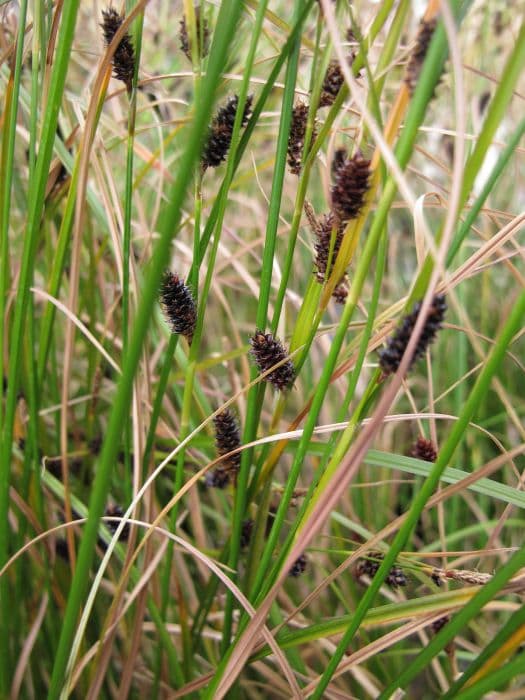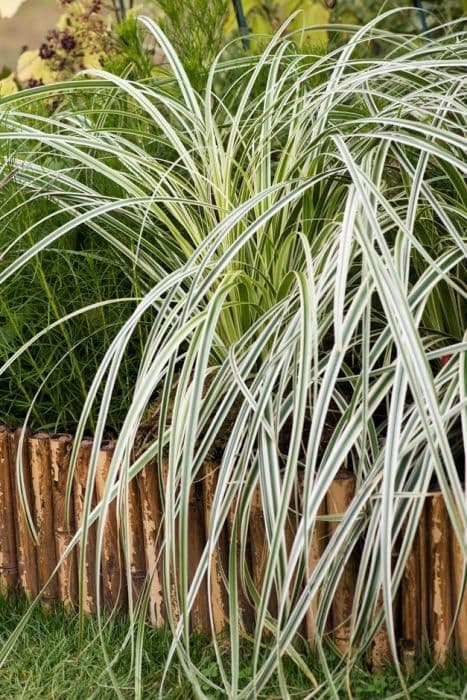Leatherleaf Sedge Carex buchananii

ABOUT
The plant commonly known as Leatherleaf Sedge has a unique and striking appearance that sets it apart in gardens and natural landscapes. The foliage of Leatherleaf Sedge exhibits a rich bronze to copper color, which can add a warm, rustic feel to its surroundings. The leaves are narrow and finely textured, creating a grass-like appearance with a delicate and slightly arching habit. The edges of the leaves have a rough, almost serrated feel, which contributes to its common name, as it somewhat resembles the texture of leather. The plant's overall form is tufted and clumping, which allows it to establish dense, fountain-like mounds in the landscape. The upright foliage can gently weep towards the tips, providing subtle movement with the breeze. When observed closely, the leaves exhibit a subtle sheen that can catch the light, further enhancing its bronze coloration. During its flowering season, Leatherleaf Sedge produces inconspicuous flowers that are held above the foliage on slender stems. These flowers are not particularly showy and tend to blend in with the rest of the plant's foliage. What really shines in this plant is its year-round color and texture, making it a versatile and attractive addition to various garden settings and landscape designs.
About this plant
 Names
NamesFamily
Cyperaceae
Synonyms
Leatherleaf Sedge, Red Rooster Sedge, Brown Sedge, Buchanan's Sedge, Orange New Zealand Sedge, Red Fox Sedge
Common names
Uncinia buchananii
 Toxicity
ToxicityTo humans
Leatherleaf Sedge (Carex buchananii) is generally not considered toxic to humans. There are no widespread reports of poisoning from ingesting any part of this plant. Consequently, should accidental ingestion occur, it is unlikely to cause harm or notable symptoms of toxicity.
To pets
Leatherleaf Sedge is also not known to be toxic to pets. It should be safe in a garden where pets roam, as ingesting parts of this plant typically does not lead to poisoning or adverse health issues in animals like cats and dogs.
 Characteristics
CharacteristicsLife cycle
Perennials
Foliage type
Evergreen
Color of leaves
Reddish-brown
Height
2-3 feet (0.6-0.9 meters)
Spread
1-2 feet (0.3-0.6 meters)
Plant type
Herb
Hardiness zones
6
Native area
New Zealand
Benefits
 General Benefits
General Benefits- Ornamental Value: Carex buchananii, commonly known as Leatherleaf Sedge, adds visual interest to gardens with its unique reddish-bronze foliage.
- Drought Tolerance: Its ability to withstand periods of drought makes it ideal for xeriscaping or low-water gardens.
- Low Maintenance: Leatherleaf Sedge requires minimal upkeep, making it a convenient choice for busy gardeners.
- Erosion Control: Its dense growth habit helps to stabilize soil and prevent erosion on slopes and banks.
- Wildlife Habitat: It provides shelter and nesting material for birds and insects.
- Seasonal Interest: The foliage of Leatherleaf Sedge retains its color throughout the seasons, offering year-round interest.
- Architectural Structure: The upright, clumping form of Carex buchananii adds structure to garden beds and borders.
 Medical Properties
Medical PropertiesThis plant is not used for medical purposes.
 Air-purifying Qualities
Air-purifying QualitiesThis plant is not specifically known for air purifying qualities.
 Other Uses
Other Uses- Carex buchananii, commonly known as leatherleaf sedge, can be used in dried flower arrangements for its unique rusty brown color and long-lasting foliage.
- The plant can be crafted into mats or screens when dried and woven due to its durability and fibrous nature.
- Leatherleaf sedge's dense tufts provide shelter and habitat for small insects and animals when used in naturalistic landscaping.
- Its vertical growth and fine texture are often utilized for adding visual contrast in rock gardens and gravel landscapes.
- Water-wise gardens benefit from leatherleaf sedge as it requires minimal irrigation once established, aiding in conservation efforts.
- Used as a soil stabilizer on slopes and banks, the plant’s root system helps prevent erosion and promotes soil health.
- In coastal areas, this sedge can be planted as part of dune restoration projects to help establish a more stable dune environment.
- Artisans may use the foliage for basketry or as a natural decorative element in handcrafted goods.
- Frequently employed in xeriscaping, the plant requires less water than traditional landscaping greens, making it ideal for drought-prone regions.
- Leatherleaf sedge can be grown as a privacy screen or garden border due to its clumping habit and height when mature.
Interesting Facts
 Feng Shui
Feng ShuiThe Leatherleaf Sedge is not used in Feng Shui practice.
 Zodiac Sign Compitability
Zodiac Sign CompitabilityThe Leatherleaf Sedge is not used in astrology practice.
 Plant Symbolism
Plant Symbolism- Resilience: Carex buchananii, commonly known as Leatherleaf Sedge, often symbolizes resilience as it can thrive in various soil conditions and is tolerant of both drought and moisture.
- Flexibility: The plant's ability to sway with the breeze without breaking is often seen as a representation of flexibility and the capacity to adapt to life's changes.
- Protection: With its dense growth habit, the Leatherleaf Sedge can serve as a protective cover for smaller plants and wildlife, symbolizing shelter and safety.
- Natural beauty: The bronze-brown coloring and fine texture of Leatherleaf Sedge give it a unique appearance that symbolizes the beauty of the natural world and encourages appreciation for native flora.
 Water
WaterLeatherleaf Sedge requires consistent moisture and should be watered regularly to maintain damp soil conditions, especially during dry spells. It is best to water deeply rather than briefly, ensuring that the water reaches the roots. Aim to provide the sedge with about 1 to 1.5 inches of water per week. Adjust watering based on climate, soil type, and season - less water may be necessary during rainy periods or cooler months. Overwatering can lead to root rot, so ensure the soil is well-draining.
 Light
LightLeatherleaf Sedge thrives best in full sun to partial shade. It prefers a spot that receives at least 4 to 6 hours of sunlight daily, but it can tolerate some light dappled shade, which can help prevent the foliage from scorching in hotter climates. Avoid deep shade, as this can lead to poor growth and a less vibrant appearance.
 Temperature
TemperatureLeatherleaf Sedge is hardy and can tolerate a range of temperatures but ideally prefers conditions between 60 to 75 degrees Fahrenheit. It can withstand temperatures as low as 20 degrees Fahrenheit but may suffer if temperatures dip below this point. The plant is generally resistant to high temperatures as long as adequate moisture is provided.
 Pruning
PruningPruning Leatherleaf Sedge is often done to remove dead or damaged foliage and to maintain its attractive shape. Trim the plant back in late winter or early spring before new growth starts. This tidy-up helps to encourage fresh growth and keeps the sedge looking neat. Pruning is generally only needed once a year unless the plant becomes unruly or sustains damage.
 Cleaning
CleaningAs needed
 Soil
SoilLeatherleaf Sedge (Carex buchananii) thrives in well-draining soil that is moderately fertile. The perfect mix would be a blend of loamy soil with added organic matter to improve drainage. A pH range of 5.5 to 7.0 is most suitable for this plant, ensuring it receives the right balance of nutrients.
 Repotting
RepottingLeatherleaf Sedge should be repotted every 2 to 3 years to refresh the soil and accommodate its growth. It does not typically require frequent repotting as it can comfortably grow in the same pot for several years.
 Humidity & Misting
Humidity & MistingLeatherleaf Sedge prefers moderate humidity levels but is quite tolerant and can adapt to the humidity levels typically found in most homes or gardens without the need for special adjustments.
 Suitable locations
Suitable locationsIndoor
Place in bright, indirect light and don't overwater.
Outdoor
Full sun to part shade in well-drained soil.
Hardiness zone
6-9 USDA
 Life cycle
Life cycleLeatherleaf sedge (Carex buchananii) begins its life cycle when seeds germinate in moist soil conditions, typically during the cooler seasons of spring or fall. The seedlings quickly establish a root system and develop into tufted clumps of narrow, copper-bronze leaves that are evergreen in milder climates. The plant matures and undergoes vegetative growth, producing dense foliage and reaching its full size, which can be up to 2-3 feet tall and wide. In summer, inconspicuous brown flower spikes emerge, leading to the formation of small seed capsules if pollination occurs. Once matured, the seeds disperse, either by wind or water, to begin a new cycle. Leatherleaf sedge is a perennial and will continue to live and go through its reproductive cycle annually, potentially showing increased clump size each year through both seed distribution and vegetative spreading from the roots.
 Propogation
PropogationPropogation time
Spring-early summer
For Leatherleaf Sedge (Carex buchananii), the most popular method of propagation is by division. This is typically done in the spring, when the plant has begun to grow actively but is not yet at its peak. The process involves carefully lifting the plant from the ground and using a sharp spade or knife to divide the root clump into smaller sections, each with several growing points. These sections are then replanted into prepared soil, ensuring that they are watered well to establish their roots. The divisions should be spaced approximately 12 inches apart (about 30 centimeters) to allow sufficient room for growth. After planting, it's important to keep the soil consistently moist until the new divisions are well-established.









